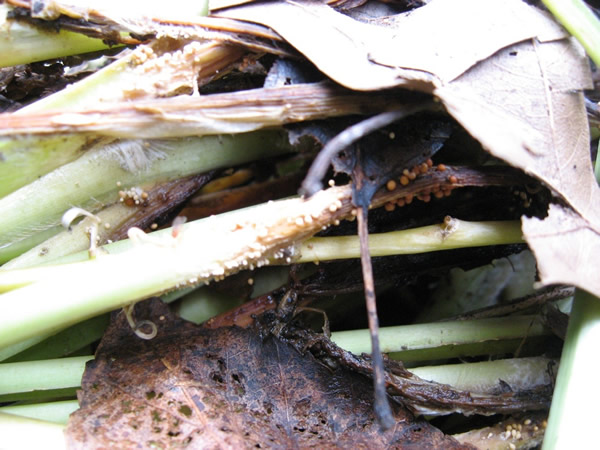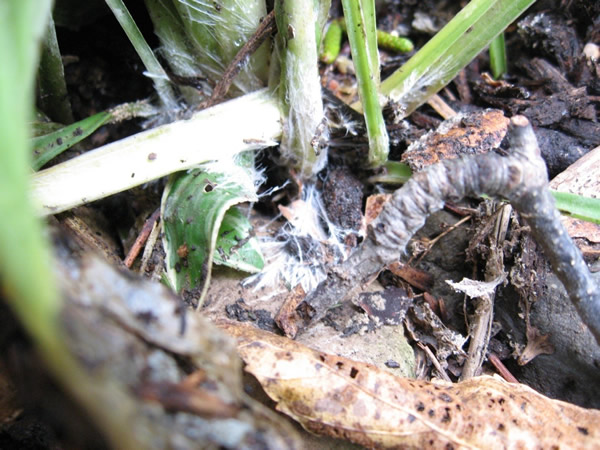Issue 9, August 12, 2021
Southern Blight
Sorry, those aren’t mustard seeds sprinkled at the base of your coneflowers. They are sclerotia, fruiting bodies produced by the southern blight fungus, Athelia rolfsii (syn. Sclerotium rolfsii). The U of I Plant Clinic recently diagnosed an Echinacea sample with southern blight. This soilborne pathogen causes basal rot to stems and petioles of herbaceous plants. It is capable of infecting a wide variety of plant species, including many annuals, perennials, woody ornamentals, and turfgrass. I have mostly encountered this pathogen infecting hosta, where it is commonly referred to as hosta petiole blight.

Mustard seed-like sclerotia of Southern Blight. Host: Hosta
Southern blight can rapidly spread under favorable environmental conditions, so it's important to scout plants and catch the disease early. Leaves will rapidly wilt, then turn yellow and become necrotic. Distinct lesions will not be seen on the leaves as the fungus is infecting the base of the plant. This also means that infected tissue (leaves on hosta, stems of other plants) can easily be pulled from the ground. A white mat of mycelium develops near the decaying stem tissues and spreads out onto the nearby soil surface. Numerous tan, brown or black mustard-seed-like structures, called sclerotia, develop within the mycelium. Sclerotia near the soil surface serve as overwintering structures. They are often seen in the mycelium, on diseased tissues above or below ground, on soil surfaces, or in soil crevices.

Southern Blight mycelium spreading over the soil surface and plant tissues. Host: Hosta
High moisture levels, both in soil and under plant canopies, and high temperatures favor southern blight. The pathogen spreads short distances within a planting occurs by mycelial growth from infected plants, plant debris, or sclerotia. Longer distance dispersal occurs as a result of moving infected plant material or infested soil.
Disease management options are limited for residential landscapes. First and foremost, avoid introducing the pathogen by purchasing healthy, disease-free plants from a reputable retailer. Inspect new plants for symptoms and signs of disease before planting. If you spot the disease in an existing planting, remove all of the infected plant parts. Do not compost diseased plants. Infected plants that remain in an area will serve as a continuous source of inoculum. Be careful not to spread any of the fungal mycelium or sclerotia. Place them directly into a bag before removing them from the site.
The mustard-seed-like sclerotia produced by the pathogen have been reported to survive in the soil for 3-4 years. Remove the top several inches of soil around the plant, again being careful not to spill any as you work. Alternatively, deep plowing (not very practical) or turning the soil to an 8-12 inch depth will bury the pathogen. Mulch and organic debris may contribute to the overwinter survival of the pathogen. Pulling mulch back from the base of plants before winter may help to kill the fungus. Improve air circulation and plant spacing to reduce moisture trapped within a dense plant canopy that favors disease development.
Fungicide options are limited, and will suppress but not completely eliminate the pathogen. Products with the active ingredient Tebuconazole list Southern Blight on their labels. Additional active ingredients are available for commercial applicators. However, those product labels prohibit use on residential landscapes.
Authors:
Travis Cleveland
Diane Plewa